RARE Antique Brass James Swift & Son London Discovery Microscope c1901-10
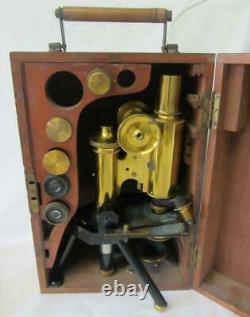
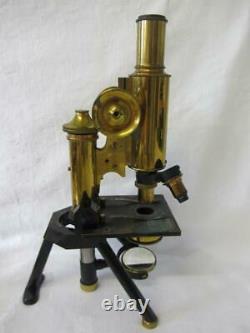
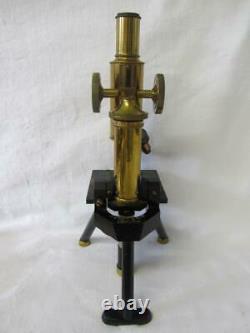


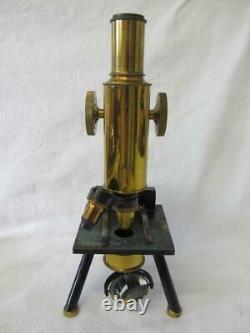
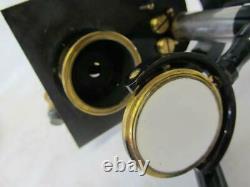
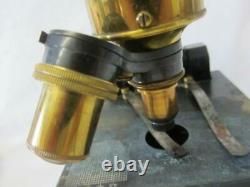
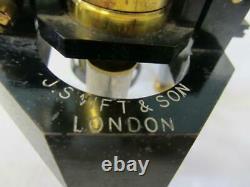
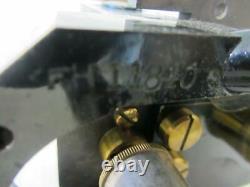

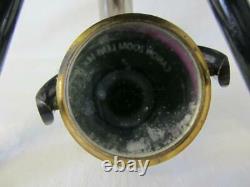

RARE Antique Brass James Swift & Son London "Discovery" Microscope c1901-10. Discovery, hence being known as the Discovery.
It is also known as the No7 and. Named "histological and physiological microscope" in the companys 1906 catalogue. Engraved on the rear of the stand J.
SWIFT & SON LONDON", on the underside is impressed "FH11840. It has rack & Pinion course and micrometer thumbwheel fine focussing. All brass with original lacquer, black lacquer to the tripod base, mirror frame etc.
Sub stage collar to fit Abbe type condenser. Two eye pieces numbered 2 & 3 Two Swift & Son London marked objectives, 2/3 and 1/6 , an unnamed objective with cannister a canister for 1/6 but not for the Swift, too small. Nickel tubed eye pieces held out by inner stop. Stage with graticule/grid front corner and spring steel stage clips. All mechanical motions smooth and functional, all in good working order, with good optics In clean bright sound used condition noting some wear to the black lacquer finish and some spotting to brass. Good sound mahogany fitted box, carrying handle looks like an old replacement as it is bamboo, working lock and key. Height of box is 12 by 8 wide. Were microscope makers trading from London and founded in 1853 by James Powell Swift, who was son of the watchmaker Thomas Swift. Before founding his company, James Swift was apprenticed to the well-known microscope maker Andrew Ross. In 1881 they made improvements to microscope design, including the replacement of the straight rack and pinion focusing to helical cut components and a new fine focus system. In 1884, Mansell James Swift, son of James Powell, joined the company and the name was changed to James Swift & Son. In 1901, Captain Scott was supplied with Swift microscopes for use on the R. In 1903, Mansell Powell John Swift, grandson of the founder, joined the company. In 1906, the founder of the company, James Powell Swift, died. In 1912, the company was incorporated as a limited company and the name changed to J. In 1942, both Mansell Powell and Mansell James died. In 1946, ER Watts and Son Ltd took over the company, mainly due to the association between the Watts and Swift families in earlier years. In 1949, they employed John H. Basset who, in 1968, took over the company. Swift & Son is known as the discovery model and was originally designed in 1901 for use on the R.Discovery for the 1901 - 1904 Antarctic expedition (the first official British exploration of the Antarctic regions since James Clark Ross's voyage sixty years earlier). The instrument is named histological and physiological microscope in the companys 1906 catalogue (Figure 1).
The stand of this microscope is a derivation of the histological model introduced by Swift in 1894. It bears the characteristic diagonal rack for the. Focusing, introduced by Swift in 1881. The original iris diaphragm is absent from microscope 7. The serial number of this microscope is B-14756. We strive very hard to offer a fast and efficient service at all times. After all, a happy customer is potentially a returning customer. We will send you a combined invoice when you are finished purchasing. However if you need more information on an item please request more specific details or photographs. Auctiva offers Free Image Hosting and Editing. The item "RARE Antique Brass James Swift & Son London Discovery Microscope c1901-10" is in sale since Tuesday, June 8, 2021. This item is in the category "Collectables\Scientific Collectables\Scientific Instruments\Microscopes". The seller is "smr1290132" and is located in Central Scotland. This item can be shipped worldwide.- Period: 1800 to 1900
- Modified Item: No
- Country/Region of Manufacture: United Kingdom
- Material: Brass
- Type: Scientific Instruments

